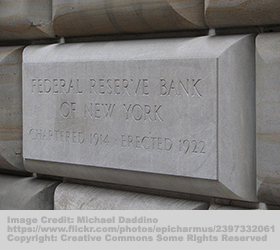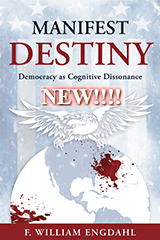
Will Fed Engineer Next Crash to Topple Trump?
By F. William Engdahl
25 September 2018
For those who follow major financial markets closely, the warning signs of the next major US financial market Tsunami are gaining more frequency daily. Some weeks ago attention was on so-called Emerging Markets, especially Turkey, Argentina, Indonesia, India or Mexico. What is rarely mentioned in the mainstream media is the relation of those events to the deliberate withdrawal of dollars from the global financial system by the “creator” of dollars, the US Federal Reserve. Now that process threatens to detonate a dramatic fall in not only US stocks but also in high-risk junk bonds, in US real estate debt, auto debt, credit card debt. The Trump hopes for continued economic success into the 2020 elections or even into the November mid-term elections may be smashed by the will of the Fed .
The interesting fact little-discussed outside professional financial circles is the fact that every major financial panic or crash since at least the Panic of 1893 in the USA has been orchestrated to the advantage of a dominant faction in finance at the expense of rivals. This was the case with the crash of 1907 where the “Federal Reserve” of that time, the faction in Wall Street around J.P. Morgan, triggered a panic to gain certain advantage over troublesome competitors. Since JP Morgan, the Rockefellers and banks of Wall Street manipulated the creation of the private Federal Reserve in 1913, it has been the Fed who engineers periodic market collapses after the same Fed policies created a speculative boom in assets previously.
The Great 1929 Crash on Wall Street was deliberately caused by Fed interest rate policies tied to pressure from Bank of England’s Montagu Norman after 1927 to lower US interest rates to encourage flow of gold into London. When US rates created a dangerous stock market bubble, the Fed moved rates higher in 1929 and burst the bubble, triggering the Great Crash and Great Depression. In the 1990s the Greenspan Fed deliberately encouraged another Wall Street speculative bubble known as the Dot.com bubble, as the Fed chairman gave speeches praising the “new economy,” and feeding a stock bubble with lowered interest rates before raising them again and popping the bubble in March 2000. After the dot.com crash the same Greenspan dramatically lowered rates again to a mere 1% in 2003, explicitly encouraging a real estate boom and praising the Wall Street creation of Mortgage-Backed Securities and “no interest loans.” When the same Greenspan began deliberately to raise Fed rates from 2006 to September 2007, a full-blown US sub-prime mortgage collapse was on. He conveniently resigned just before.
QT and the Coming Bubble Bust
Now the Fed is in the early stages of yet another interest rate tightening cycle, raising rates after an unprecedented ten years of zero rates and Quantitative Easing. In addition to raising rates, it is also unwinding the QE with what is known as Quantitative Tightening—selling off the Treasuries and other bonds it acquired during the past decade of QE, in effect reducing available bank credit. It began timidly in 2017 with ever-so-gradual Fed interest rate hikes from the zero levels of the past eight years. Now with a new Fed chairman, Jerome Powell, rates look set to rise significantly in coming months.
It began timidly in 2017 with ever-so-gradual Fed interest rate hikes from the zero levels of the past eight years. Now with a new Fed chairman Jerome Powell, rates look set to rise significantly in coming months. At the same time the Fed has begun to reverse its purchase of some $4 trillion of US Treasury and corporate bonds and assets during the past decade. To date they have sold $231 billion of Treasuries and mortgage-backed securities, withdrawing the equivalent in banking system liquidity.
The combined impact of rising Fed rates and liquidation of its Treasury holdings from QE is creating a dollar liquidity squeeze worldwide. While the impact so far has first been felt in vulnerable emerging markets like Turkey or Argentina, in recent weeks it has begun to force domestic US interest rates higher and threatens to end the euphoric Wall Street stock bubble that began a decade ago. Since the onset of the crisis in 2008 the S&P 500 stock index has risen an unprecedented 387%, for reference.
Now if we add to the mix the fact that owing to the generous Trump tax cuts and a rise in military and other spending, the Federal US deficit is due to hit nearly $1 trillion this year, and remain at those levels for at least a decade, with Washington in a trade war with China, it’s largest creditor, as well as with Japan, events are primed for rising US interest rates even somewhat independent of the Fed.
A US Debt Bubble
A decade of the lowest Fed interest rates in history has created a grotesque distortion in borrowing in most every sector of the US economy from Federal government to corporations to households. The Federal government debt is presently a record $21 trillion, more than double what it was in 2008 when the Lehman crisis erupted. US corporate debt is an unprecedented $6.3 trillion and only sustainable so long as interest rates remained at record lows.
Debt of US households is more than $13.3 trillion, well above the 2008 peak. Of that most is again mortgage debt, at over $9 trillion, near the level of 2008. Of this debt of households an unprecedented $1.5 trillion is student loan debt. In 2008 that figure was less than half or $611 billion. Add another $1.25 in auto loans and record credit card debt and the stage is set for the US to get caught in a classic debt trap once rising Fed interest rates trigger domino-style bankruptcies as companies and home mortgage holders are unable to meet debt payments and defaults rise.
While it is not at all clear that rising Fed interest rates will trigger a stock market crash in time for the November mid-term elections, the stage is clearly set for the Fed to put the US economy into a severe recession or depression by the time of the 2020 elections. That would finish the Trump presidency should the Powers That Be decide another option is more useful to their global power agenda.
“We won’t be able to call it a recession, it’s going to be worse than the Great Depression,” said Peter Schiff, fund manager who anticipated the 2007 sub-prime crash. Schiff predicts a major economic downturn before the end of the Trump presidency’s first term. “The US economy is in so much worse shape than it was a decade ago.” Only this time the Fed is in a far weaker position than in 2008 and the total US debt is far beyond levels of a decade ago. The US economy and US Government is not as invincible as it appears to some. The question is what would replace it? The China-Russia-Iran Eurasia alternative, the most promising alternative needs to take far more consequent steps to isolate their economies from the dollar if they are to succeed.
F. William Engdahl is strategic risk consultant and lecturer, he holds a degree in politics from Princeton University and is a best-selling author on oil and geopolitics, exclusively for the online magazine “New Eastern Outlook”
